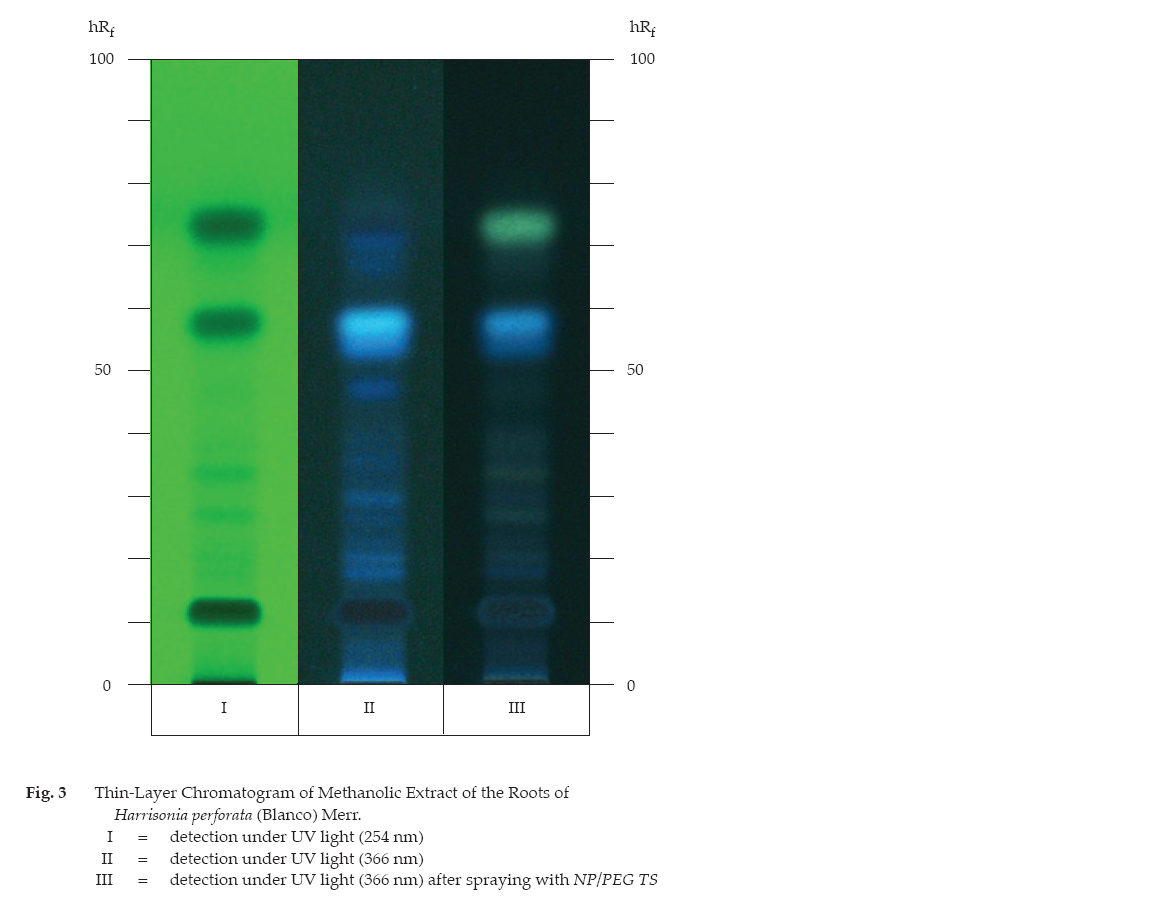ตำรามาตรฐานยาสมุนไพรไทย
Thai Herbal Pharmacopoeia
สำนักยาและวัตถุเสพติด กรมวิทยาศาสตร์การแพทย์ กระทรวงสาธารณสุข
Bureau of Drug and Narcotic, Department of Medical Sciences, Ministry of Public Health(Tinospora crispa (L.) Hook.f. & Thomson)
(Nelumbo nucifera Gaertn.)
(Centella asiatica (L.) Urb.)
(Centella Dry Extract)
(Centella Cream)
(Mesua ferrea L.)
(Piper sarmentosum Roxb.)
(Piper sarmentosum Roxb.)
(Pterocarpus santalinus L. f.)
(Santalum album L.)
(Senna tora (L.) Roxb.)
(Senna alata (L.) Roxb.)
(Senna Alata Tea)
(Piper retrofractum Vahl)
(Myristica fragrans Houtt)
(Andrographis paniculata (Burm. f.) Nees)
(Andrographis Capsules)
(Allium ascalonicum L.)
(Ocimum tenuiflorum L.)
(Curcuma longa L.)
(Turmeric Capsules)
(Turmeric Dry Extract)
(Turmeric Dry Extract Capsules)
(Arcangelisia flava (L.) Merr.)
(Curcuma sp.)
Harrisonia perforata (Blanco) Merr.
(Aristolochia pierrei Lecomte)
(Zingiber officinale Roscoe)
(Ginger Capsules)
(Ginger Tea)
(Cassia fistula L.)
(Nardostachys jatamansi (D. Don) DC.)
(Angelica sinensis (Oliv.) Diels)
Artemisia annua L.
(Ligusticum sinense Oliv. cv. Chuanxiong)
(Neopicrorhiza scrophulariiflora Pennell)
(Atractylodes lancea (Thunb.) DC.)
(Aucklandia lappa Decne)
(Terminalia chebula Retz.)
(Angelica dahurica (Hoffm.) Benth. & Hook. f. ex Franch. & Sav. var. dahurica)
(Kaempferia parviflora Wall. ex Baker)
(Hibiscus sabdariffa L.)
(Roselle Tea)
(Allium sativum L.)
(Zingiber zerumbet (L.) Sm.)
(Wurfbainia testacea (Ridl.) Škorničk.& A. D. Poulsen)
(Cannabis sativa L.)
(Myristica fragrans Houtt)
(Dracaena cochinchinensis (Lour.) S. C. Chen)
(Ficus racemosa L.)
(Hyptis suaveolens (L.) Poit.)
Clerodendrum indicum (L.) Kuntze
(Phyllanthus emblica L.)
(Citrus hystrix DC.)
(Citrus hystrix DC.)
(Areca catechu L.)
(Momordica charantia L.)
Moringa oleifera Lam.
(Aegle marmelos (L.) Corrêa)
(Solanum trilobatum L.)
(Morus alba L.)
Gynostemma pentaphyllum(Thunb.)
Makino
(Clinacanthus nutans (Burm. f.) Lindau)
(Cissus quadrangularis L.)
(Mimusops elengi L.)
(Zingiber montanum (J. König) Link. ex A. Dietr.)
(Piper betle L.)
(Capsicum annuum L.)
(Capsicum Oleoresin)
(Capsicum Gel)
(Piper nigrum L.)
(Piper nigrum L.)
(Eurycoma longifolia Jack)
(Thunbergia laurifolia Lindl.)
(Piper wallichii (Miq.) Hand.-Mazz.)
Senna garrettiana (Craib) H. S. Irwin & Barneby
(Terminalia bellirica (Gaertn.) Roxb.)
(Terminalia chebula Retz.)
(Caesalpinia bonduc (L.) H. Roxb.)
(Tarlmounia elliptica (DC.) H. Rob., S. C. Keeley, Skvaria & R. Chan)
(Hog Creeper Vine Dry Extract Capsiles)
(Hog Creeper Vine Dry Extract)
(Brachypterum scandens (Roxb.) Miq.)
(Lepidium sativum L.)
(Nigella sativa L.)
(Cuminum cyminum L.)
(Foeniculum vulgare Mill.)
(Plantago ovata Forssk.)
(Pimpinella anisum L.)
(Carum carvi L.)
(Anethum graveolens L.)
(Trachyspermum ammi (L.) Sprague)
Albizia procera (Roxb.) Benth.
(Acorus calamus L.)
(Tiliacora triandra (Colebr.) Diels)
Cyanthillium cinereum (L.) H. Rob.
(Orthosiphon aristatus (Blume) Miq.)
Murdannia loriformis (Hassk.) R. S. Rao & Kammathy
(Capparis micracantha DC.)
(Chrysopogon zizanioides (L.) Roberty)
(Cyperus rotundus L.)
(Cannabis sativa L.)
(Syzygium aromaticum (L.) Merr. & L. M. Perry)
(Boesenbergia rotunda (L.) Mansf.)
(Acanthus ebracteatus Vahl)
(Acanthus ilicifolius L.)
(Kaempferia galanga L.)
(Curcuma comosa Roxb.)
Betula alnoides Buch.-Ham. ex D. Don
Cannabis sativa L.
Carthamus tinctorius L
Mitragyna speciosa (Korth.) Havil
Mallotus repandus (Rottler) Müll. Arg
Azadirachta indica A. Juss. var. siamensis Valeton
Azadirachta indica A. Juss. var. siamensis Valeton
Punica granatum L.
Rhinacanthus nasutus (L.) Kurz
Baliospermum solanifolium (Burm.) Suresh
Curcuma aeruginosa Roxb
Boesenbergia kingii Mood & L. M. Prince
Senegalia rugata (Lam.) Britton & Rose
Acacia concinna (Willd.) DC.
Senegalia rugata (Lam.) Britton & Rose
Acacia concinna (Willd.) DC.
Senna alexandriana Mill. var. alexandriana
Cassia acutifolia Delile, Cassia angustifolia Vahl
Butea superba Roxb. ex Willd.
[Plaso superba (Roxb. ex Willd.) Kuntze, Rudolphia superba (Roxb. ex Willd.) Poir.
Pueraria candollei Graham
ex Benth. var. mirifica (Airy Shaw & Suvat.) Niyomdham
Streblus asper Lour.
Suregada multiflora (A. Juss.) Baill. (Gelonium
multiflorum A. Juss.
Plumbago zeylanica L.
Plumbago indica L.
Biancaea sappan (L.) Tod.
Ziziphus attopensis Pierre
Streblus asper Lour.
Justicia gendarussa Burm. f.
Enhalus acoroides (L. f.) Royle
Bridelia ovata Decne.
Tamarindus indica L.
Citrus × aurantiifolia (Christm.) Swingle
Garcinia mangostana L.
Blumea balsamifera (L.) DC
Persicaria odorata (Lour.) Soják
Zingiber montanum (J. König) Link ex A. Dietr.
Mammea siamensis (Miq.) T. Anderson
Citrus maxima (Burm.) Merr.
Citrus × aurantium L. ‘Som Sa’
Punica granatum L.
Rhinacanthus nasutus (L.) Kurz
Harrisonia Perforata Root is the dried root of Harrisonia perforata (Blanco) Merr. (Paliurus perforatus Blanco) (Family Rutaceae), Herbarium Specimen Number: DMSC 5218, Crude Drug Number: DMSc 1080.
Constituents Harrisonia Perforata Root contains limonoids (e.g., harperfolide, harrisonin, obacunone) and chromones (e.g., harperamone). It also contains coumarins, sterols, etc.
Description of the plant (Figs. 1a, 1b) Erect or straggling shrub, up to 5 m tall, rarely small tree; thorn conical, straight or slightly curved, woody cylindrical-shaped in old stem. Leaves spirally arranged, imparipinnate, with 1 to 7 pairs of leaflets, up to 20 cm long; petiole reddish, 0.5 to 4.5 cm long; rachis narrowly winged; leaflet subsessile, lanceolate or ovate-oblong, 1 to 5 cm long, 0.5 to 2 cm wide, apex acute or obtuse, base acute or obtuse, unequal-sided, margin crenate-serrate, glabrous, sometimes pubescent on nerves. Inflorescence cymose, 8- to 20-flowered, in upper leaf axils and end of twigs, 12 to 20 cm long, rarely solitary flower; peduncle 7 to 11 cm long. Flower purplish red outside, creamy white inside, pubescent; pedicel 3 to 4 mm long, pubescent; calyx small, 4- or 5-lobed, lobe broadly triangular, apex obtuse, pubescent outside; petals 4 to 5, oblong-obovate or lanceolate, 5 to 9 mm long, 2 to 4 mm wide, apex acute, pubescent on both surfaces; stamens 8 or 10, filament 6 to 8 mm long, whitish, glabrous or pubescent, attached to edge of cup-shaped disc; ovary superior, 0.5 to 1 mm long, 4- or 5-loculed, ovule 1 per locule, style 5 to 8 mm long, pubescent, stigma knob-like. Fruit berry, subglobose, 4 to 9 mm long, 1 to 1.5 cm wide, slightly lobed, glabrous, endocarp hard, with 3 to 5 seeds.
Description Odourless; taste, bitter.
Macroscopical (Fig. 1a) Obliquely, longitudinally or transversely sliced roots, varied in shape and size; bark 1 to 3 mm thick, greyish brown to brownish, with scattered irregular scars; wood pale yellow with dark brown rings in the centre.
Microscopical (Figs. 2a, 2b, 2c, 2d) Transverse section of the root shows periderm, cortex, phloem, vascular cambium, and xylem. Periderm, several layers of small rectangular cork cells. Cortex, various sizes and shapes of thin-walled parenchyma cells, fibres, and round- or oval-shaped lysigenous intercellular spaces, some containing yellow or brown substance; with starch grains, yellow or brown substance, and rosette aggregate crystals scattered throughout parenchyma tissue. Phloem, converse V-shaped broad zones of small thinwalled parenchyma cells, some containing starch grains, groups of fibres, phloem rays, and round- or oval-shaped lysigenous intercellular spaces, some containing yellow or brown substance. Vascular cambium, several layers of small thin-walled rectangular cells. Xylem, bordered-pitted vessels (some of which contain tylose), xylem parenchyma, fibres, and xylem rays, some containing starch grains.
Radial and tangential longitudinal sections of the woody part of the root show bordered-pitted vessels, bundles of fibres and medullary rays.
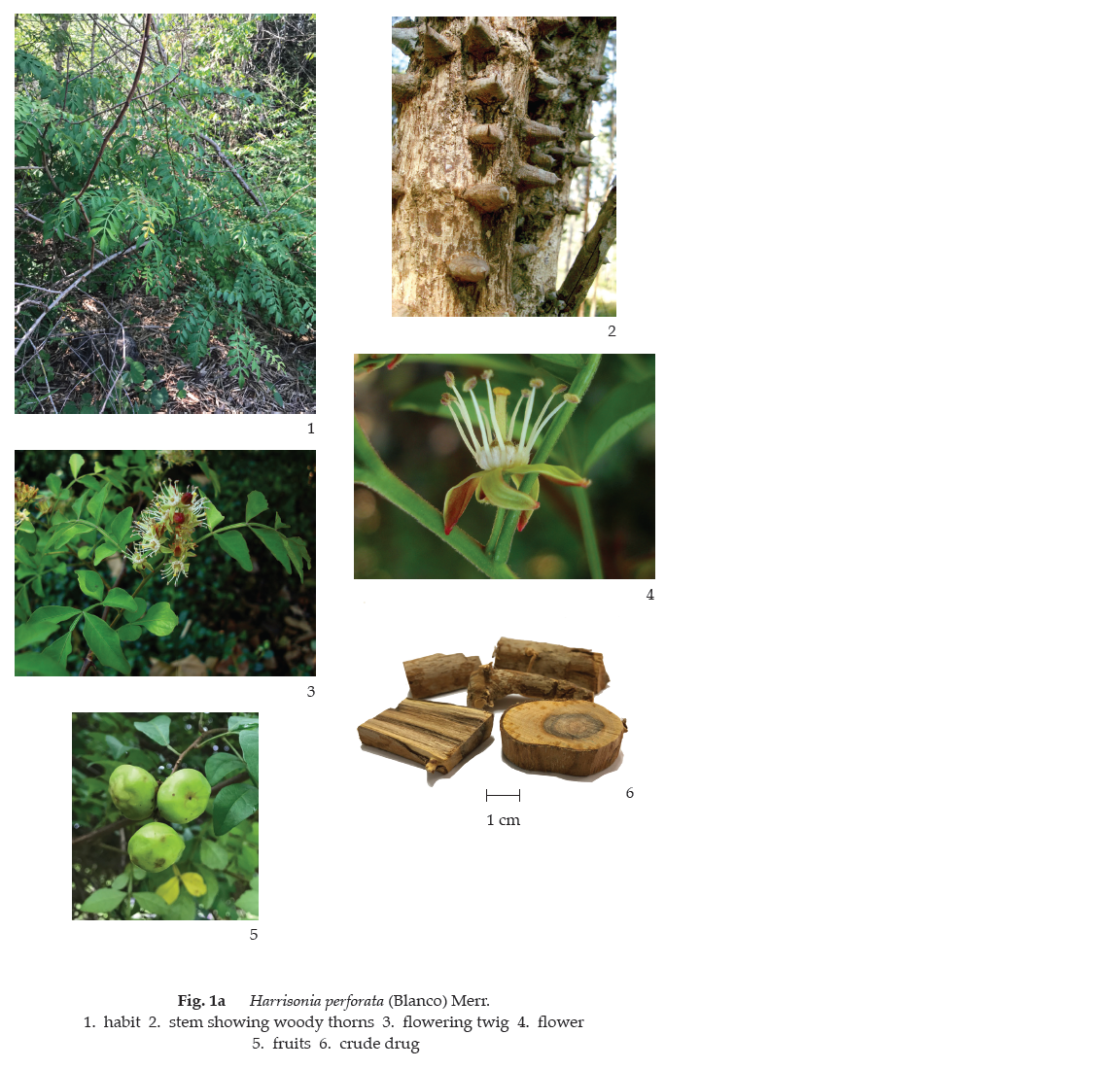
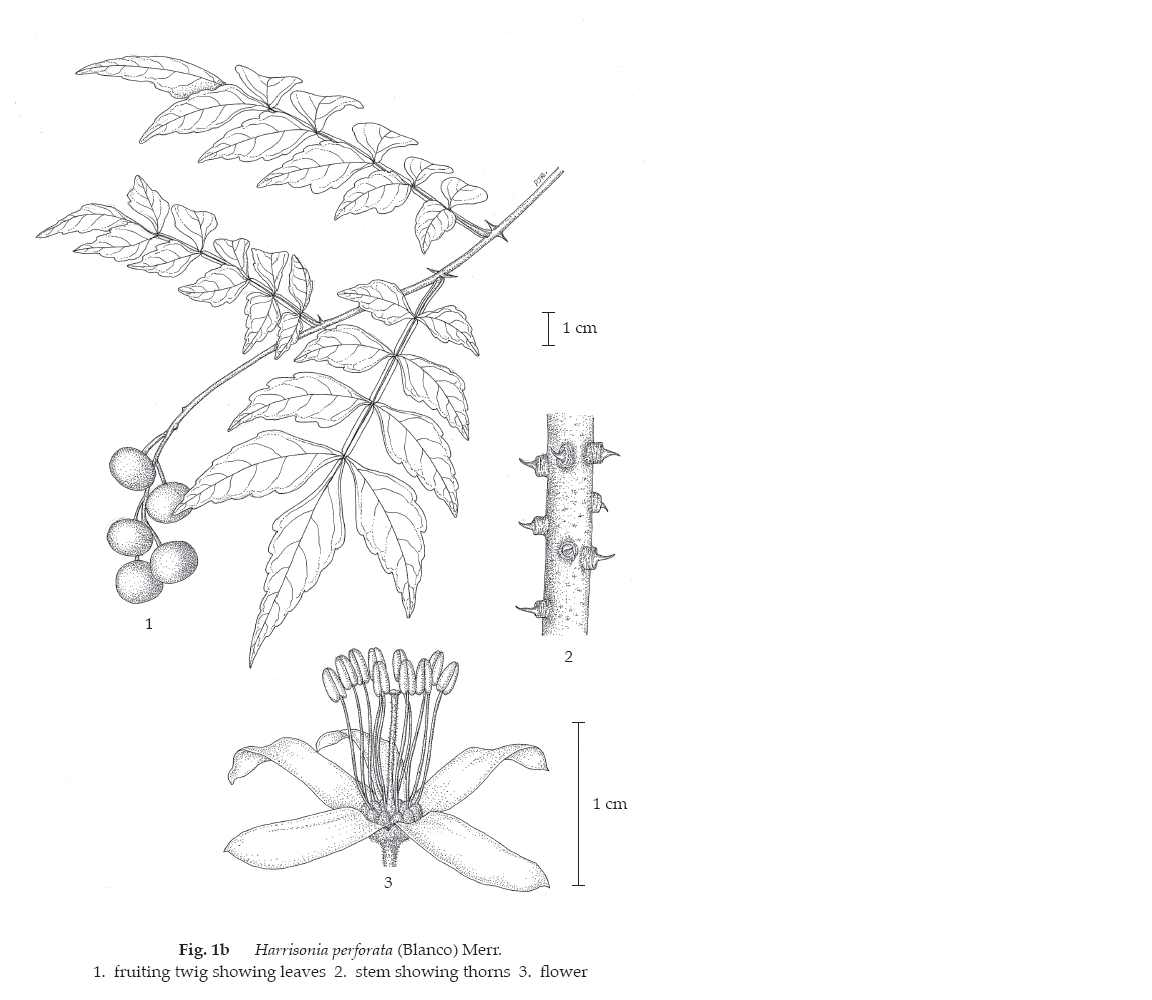
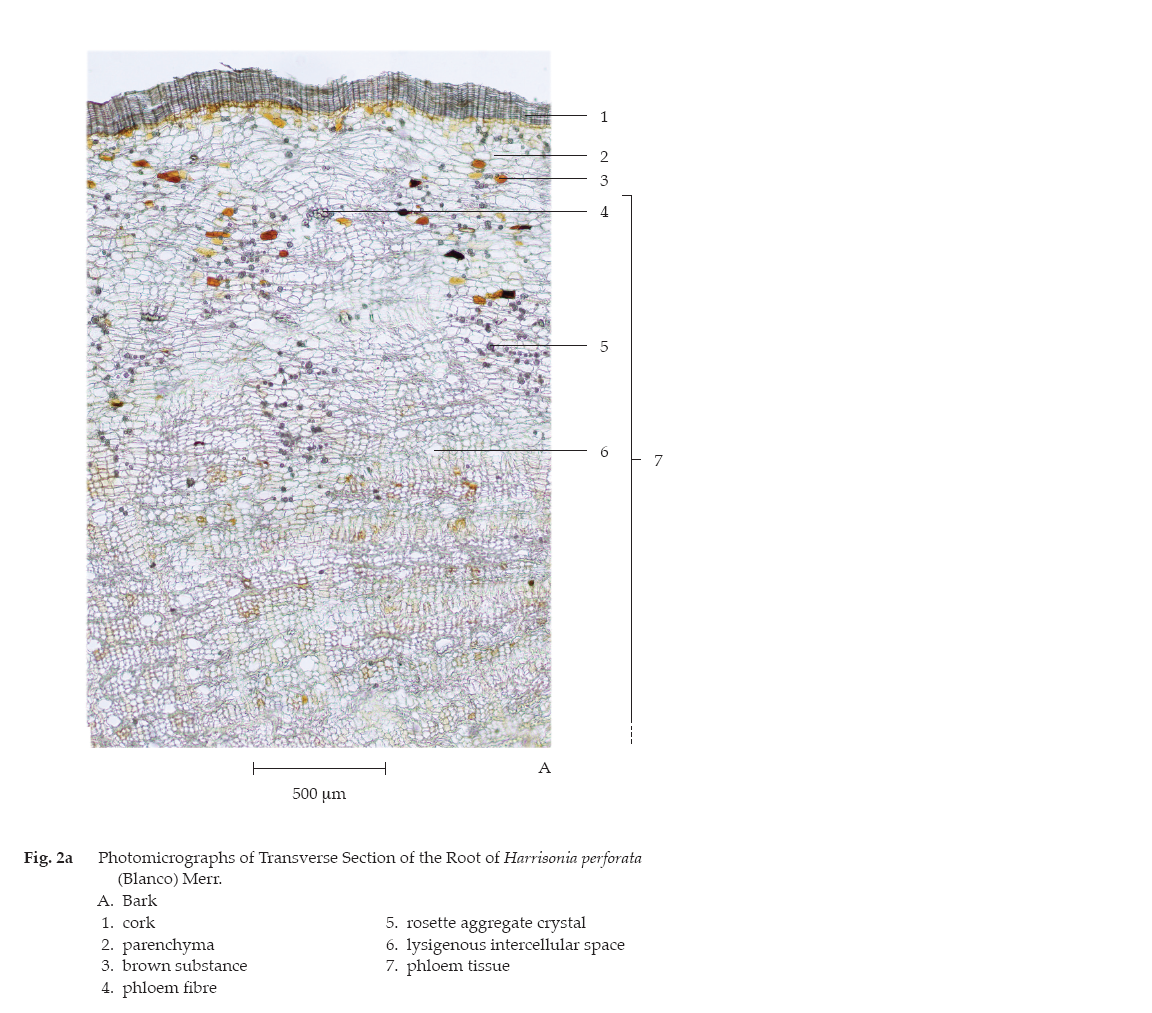
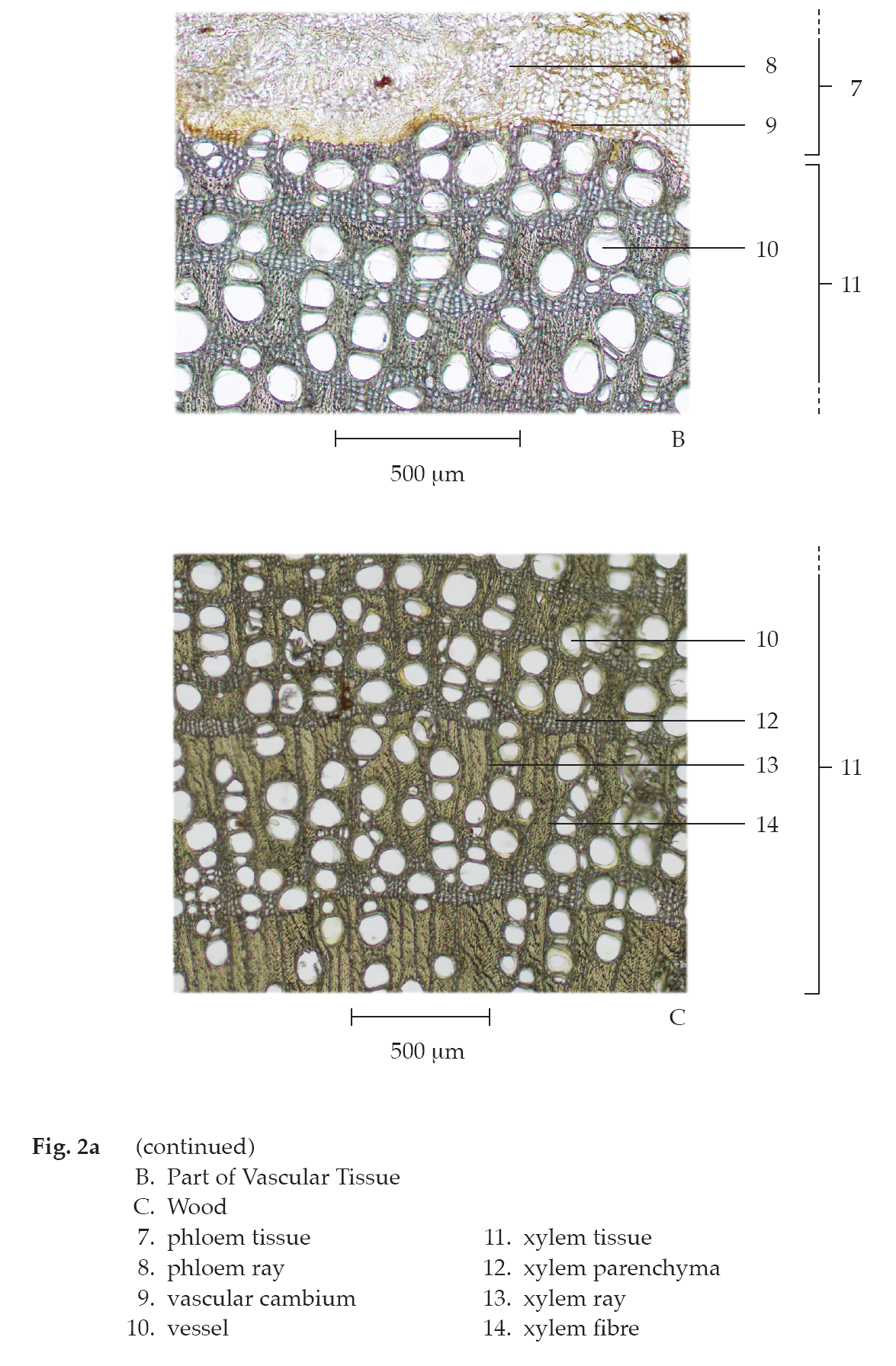
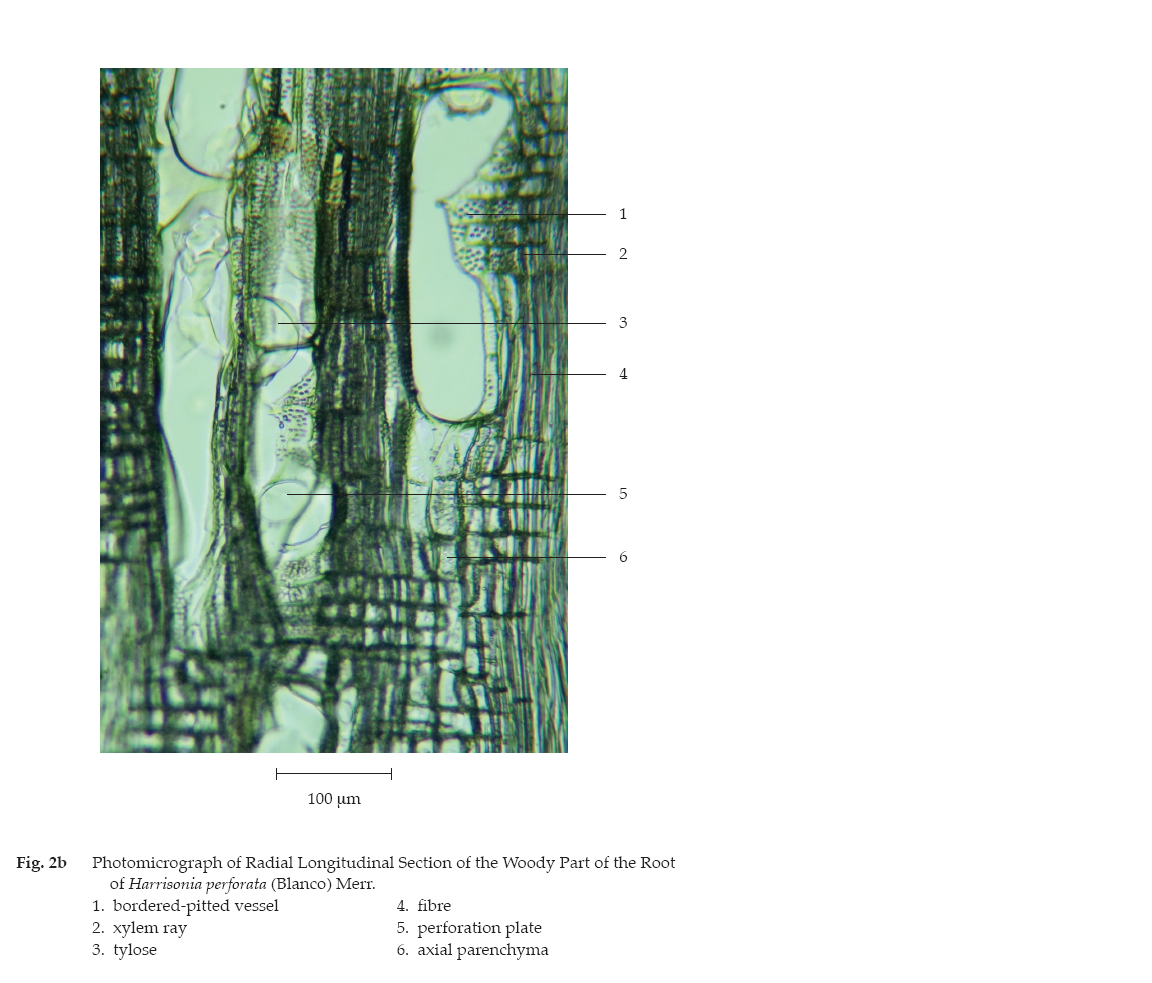
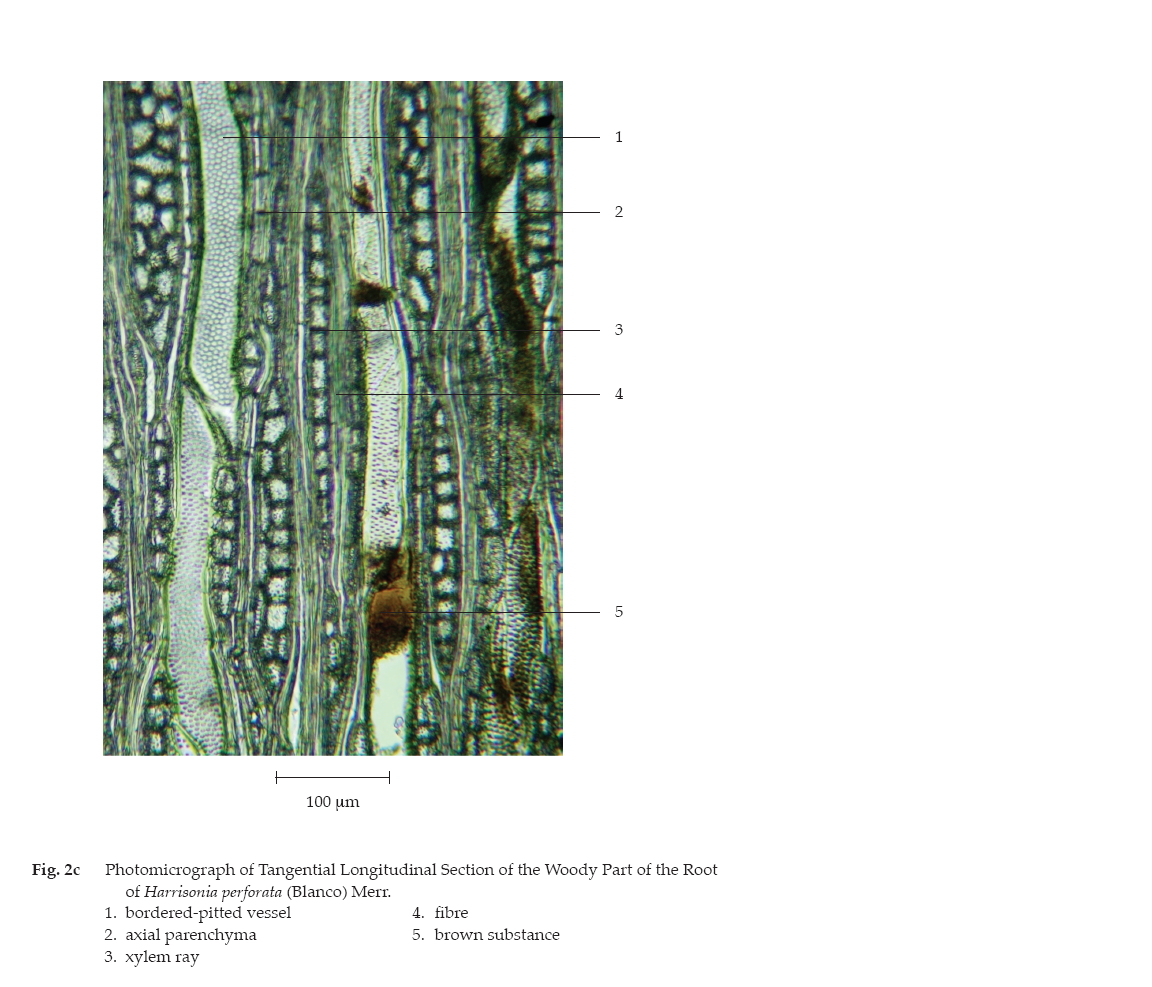
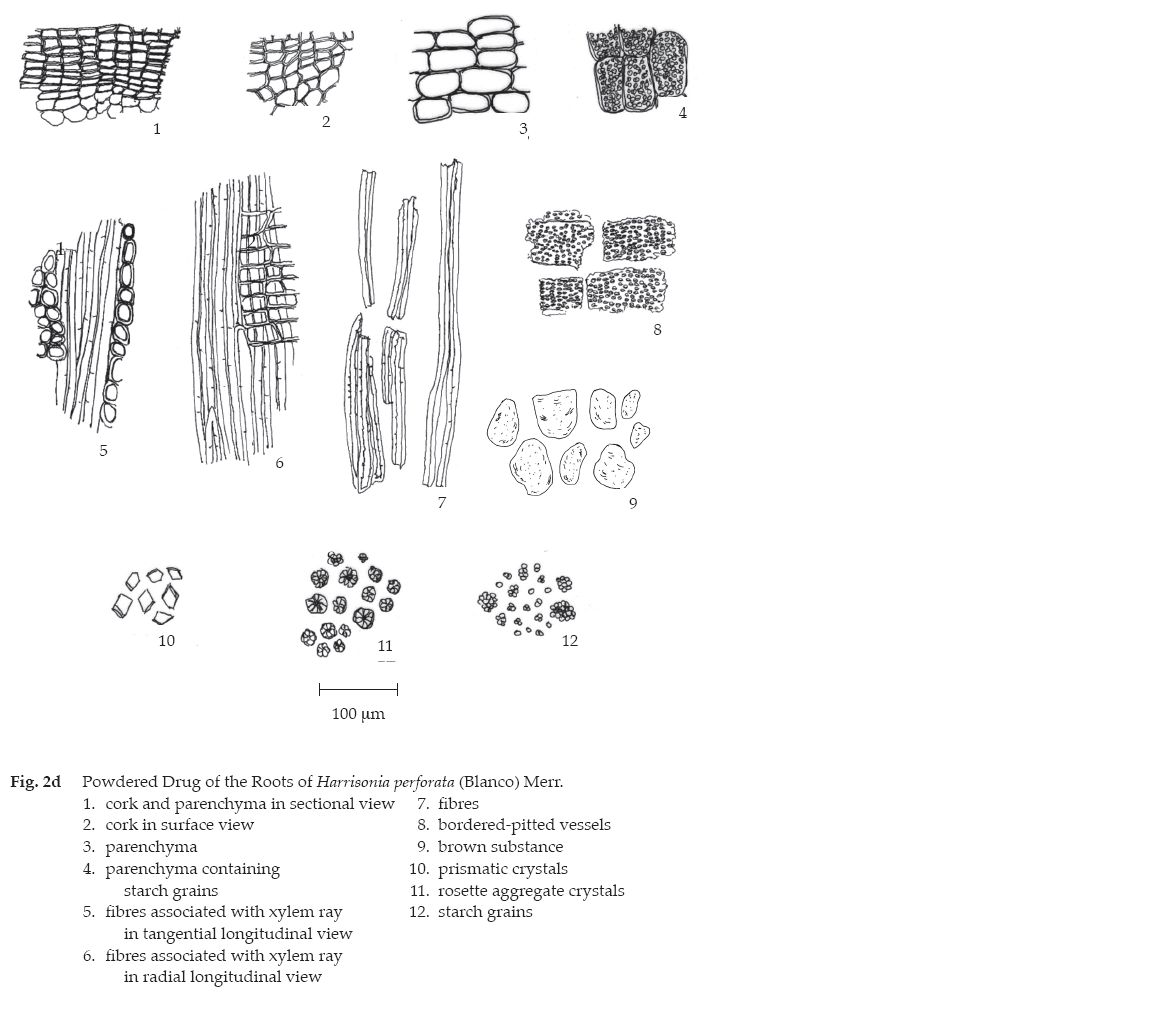
Harrisonia Perforata Root in powder possesses the diagnostic microscopical characters of the unground drug. Parenchyma tissue with starch grains, fibres associated with medullary rays, brown substance, and rosette aggregate crystals can be seen in abundance. Cork in various views and bordered-pitted vessels may also be observed.
Additional information In Thai herbal markets, the adulteration of harrisonia perforata root with stems, branches, etc. may be found.
Packaging and storage Harrisonia Perforata Root shall be kept in well-closed containers, protected from light, and stored in a dry place.
Identification
A. Macerate 100 mg of the sample, in fine powder, with 4 mL of ethanol for 5 minutes and filter. To 2 mL of the filtrate, add 2 or 3 pieces of magnesium ribbon, shake well and mix with a few drops of hydrochloric acid: a yellow-orange colour develops.
B. Carry out the test as described in the “Thin-Layer Chromatography” (Appendix 3.1), using silica gel GF254 as the coating substance and a mixture of 95 volumes of chloroform, 5 volumes of methanol and 0.5 volume of formic acid as the mobile phase and allowing the solvent front to ascend 8 cm above the line of application. Apply to the plate as a band of 8 mm, 10 μL of the test solution prepared by macerating 500 mg of the sample, in fine powder, with 4 mL of methanol for 15 minutes and filtering. After removal of the plate, allow it to dry in air and examine the plate under ultraviolet light (254 nm), marking the quenching bands. Examine the plate under ultraviolet light (366 nm) through the cut-off filter; several fluorescent bands of different colours are observed. Heat the plate at 80° for 10 minutes and then spray with natural products (NP) TS while the plate is still warm. Subsequently spray the plate with polyethyleneglycol (PEG) TS and observe the colours of the bands under ultraviolet light (366 nm) through the cut-off filter within 5 to 15 minutes. Several fluorescent bands of different colours are observed (Table 1); see also Fig. 3.
Table 1 hRf Values of Components in Methanolic Extract of the Roots of Harrisonia perforata (Blanco) Merr.
| Band |
hRf Value |
Detection | ||
| UV 254 | UV 366 | NP/PEG TS and UV 366 |
||
| 1 2 3 4 5 6 7 8 9 10 11 |
10-14 17-19 20-21 26-28 28-31 32-34 46-49 52-55 56-60 69-71 72-76 |
quenching weak quenching weak quenching weak quenching - weak quenching - - quenching - quenching |
- blue blue - blue - blue blue bright blue blue - |
- light blue light greenish yellow light greenish yellow light blue light greenish yellow - blue blue - greenish yellow |
Loss on drying Not more than 9.0 per cent w/w after drying at 105° to constant weight (Appendix 4.15).
Foreign matter Not more than 2.0 per cent w/w (Appendix 7.2).
Total ash Not more than 4.0 per cent w/w (Appendix 7.7).
Ethanol-soluble extractive Not less than 2.0 per cent w/w (Appendix 7.12).
Water-soluble extractive Not less than 3.0 per cent w/w (Appendix 7.12).
